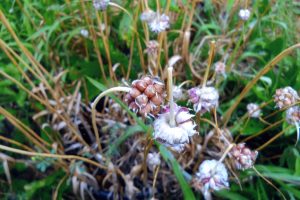
Tree Onion

Tree Onion
Q. My landlord gave me a start of this plant. They didn’t explain what it is. I have looked in the seed catalogs and don’t see anything like it. Would like to know if the little bulbs are edible. – P.B., Summitville, Indiana
A. Excellent photos! This distinctive perennial onion is known as Egyptian, tree or top-set onion, so-named for the cluster of aerial bulblets, called bulbils, produced at the tip of the leaves. The bulbils are edible and are also used for propagating new plants. The plants also produce edible, bunching-type onions at the base of the leaves in the soil.
To propagate tree onions, you can either leave the bulbils in place, where their weight bends the leaves to the soil. Or you can gather them as they mature and either plant immediately or store until early fall. If planted in early fall and allowed to overwinter in the garden, the bulbs begin growth early in spring and can be pulled for an early supply of green onions.
Q. I need help with the control of potato beetles and wire worms. Do you know anything to spray or powder to destroy them? – E.R., Walkerton, Indiana
A. Specific recommendations depend on the specific crops in question and accurate identification of the insect pests. Colorado Potato Beetle and wireworms can attack a number of vegetable crops in addition to potatoes.
According to Purdue Extension entomologists, Colorado Potato Beetle has developed resistance to many of the commonly used home garden insecticides, but there are a few strategies that can help. Microbial insecticides such as spinosad and Bacillus thuringiensis (Bt) formulations specifically labeled for potato beetles can be effective, but applications must be timed when the larvae are small and vulnerable to treatment. Handpicking adult beetles off the plants and destroying them before they begin to lay their orange-red eggs on the undersides of the leaves will reduce future damage. Applying a 4-6 inch layer of straw mulch on both sides of the potato row immediately after hilling can also reduce future populations.
Wireworms feed on a large range of vegetable crops but are rarely a serious pest in established home gardens. Wireworms are more likely to be present in large numbers in new gardens that were in sod last year or those that have a lot of grassy weeds present. If the wireworms continue to be a problem, you might consider growing potatoes in containers with soilless media rather than garden soil.
For more information, see Purdue Extension publications “Controlling Insect Pests in the Home Vegetable Garden” athttp://extension.entm.purdue.edu/publications/E-21.pdf and “Potatoes” at http://www.hort.purdue.edu/ext/HO-62W.pdf.